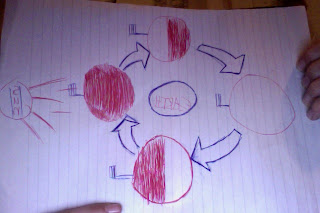"Have you ever noticed that when you write on a black sheet of paper with a black marker you so not see the marker?" -(Copy right of Sofia Infante.)
Well the phases of the moon are exhibiting the same thing.
Alex and I were making observation with a flashlight as the sun, a small ball as the moon and a different ball 4 times bigger than the small ball as earth. What alex and i made sure that we did, is the we mark where we are on earth.
From our testing i observed that when the moon is aligned with the sun and the earth (the moon in between the sun and earth) you cannot see the moon or you can only see a very little bit ,a crescent because the sun is shining on the front face of the moon that isn't facing the earth, only the side that is black is facing earth but its a black moon in a black solar system. Black on black in unseen!
But when the earth is in-between the earth and the moon you can see the moon because the sun is shining on the part of the moon facing you. A white chalk on a black piece of paper is seen!!
These are some of the pictures that we took of our testings:
As you can see the sun is shining on the face the moon that is not facing you, only the dark side is facing you.
But here the sun is shiny on the earth and the moon the bright side of the moon is facing you giving you a full moon.
Analyze and conclude: Question Review p.29 chapter 1
Book: Astronomy
Prentice Hall Science Explorer
- In our model, a flashlight represents the sun, a mini ball represents the moon and a larger ball represents the earth.
- When the sun was facing the flashlight and the moon was behind the earth i could see the moon.
-
4. After each turn you see 1/2 of the moon more or less. It always increases then decreases, from this drawing. But if you include the wanning and waxing gibbous and the wanning and waxing crescents the moon increases or decreases by 1/4.
5. Since the moon rotates with one side/ 1/2 of the moon always facing the sun, its just the way the moon rotates.The darkness of the moon is not caused by an eclipse.
6. This model did help me understand the phases of the moon but not in every way that it should have. I did have to research a bit after i made the diagram because some parts just didn't make sense. The advantages of having a model is that you have a visual but the disadvantage is that there are no word to explain it. I think model are a good thing to use but for me they aren't help full if they aren't backed up with words.


